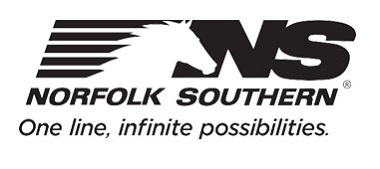NS continued to become more fluid this month, as average train speed was up 15 percent and terminal dwell was down 11 percent compared to the fourth quarter, Chief Operating Officer Mike Wheeler said on the railroad’s earnings call on Thursday.
“This has been achieved by a healthier [train and engine] crew base, clean sheeting gaining further traction, the full implementation of our network operations center, and intense energy and execution by the field,” Wheeler says.
The railroad is now moving faster than it has in nearly two years, according to data NS reports to the Association of American Railroads. The railroad began to bog down more than a year ago in the Southeast amid crew shortages and volume growth that plugged terminals and single-track main lines.
NS began the clean-sheeting process last year to redesign local and yard service. The process accelerated in the fourth quarter, Wheeler says, and will be completed by mid-summer.
Then NS will launch its new operating plan, which will be based on the principles of Precision Scheduled Railroading. The railroad is phasing in operational changes now, however, where it makes sense to do so, Wheeler says.
NS completed the move of its dispatchers to its new operations center in Atlanta last month, which it says helps improve coordination as trains move across the system.
“There is a lot of urgency around here and a lot of enthusiasm, energy, and excitement about this new mode of operations we are adopting based on Precision Scheduled Railroading,” CEO Jim Squires says.
NS brought in consultants last year with PSR experience, Squires noted, and hired one of them, Michael Farrell, as senior vice president of transportation, in November.
“It’s working. You see it in the service metrics thus far in the first quarter in the latter part of the fourth quarter as well,” Squires says. “So it’s clearly taking hold. We feel like there’s a lot of momentum.”
Federal regulators have raised questions about the way Class I railroads are implementing the late E. Hunter Harrison’s PSR operating model.
NS, like Union Pacific and CSX Transportation, has notified customers about changes to demurrage and accessorial charges, which the railroads levy on shippers for things such as car storage, special switching requests, and releasing freight cars with incomplete shipping instructions.
The changes are designed to encourage shippers to more quickly load and unload railcars.
Chief Marketing Officer Alan Shaw says NS is collaborating with customers and working with them to make operations more efficient so that both shippers and the railroad benefit.
“They want us to succeed and they want a supply chain partner that can support their growth. And so their goals are aligned with ours,” Shaw says. “We’re focused on improving service and also putting a product out there that lets them compete.”
NS does not expect a revenue windfall from the new charges, executives say.
The railroad will provide full details on its new operating plan, service metrics, and financial targets at an investor day scheduled for Feb. 11 in Atlanta.















Start with the shipper. Can the shipper directionally load for certain days of the week? What if a plastic pellet yard in south Texas shipped California and the west Coast Monday, Chicago area Tuesday, Memphis Wednesday etc? Instead of being humped at the first yard it could be immediately added to a ready train and save at least a day transit. My first job here (1980) was with Kinney shoes and that’s how we loaded the motor carriers with shoes for the new Footlocker stores. They wanted shoes Thursdays for peak weekend sales so we picked and loaded on the day of the week that ensured a Thursday arrival. Precision!
Before that in London Guinness’s Park Royal Brewery loaded to numerous destinations. The local 1635 from Park Royal to Acton Yard was preblocked so that on arrival at 1715 wagons of beer made connections for departures at 1735, 1740, 1915 and 1940. The railroads need to take advantage of the repetitive nature of many shippers movements to reduce the number of times cars are handled. Hump Yards are obsolete. Yard Masters should be planning trains based on what is en route more than what is on hand. An empty yard is a happy yard!
“This has been achieved by a healthier [train and engine] crew base…” Wheeler says.
That’s what drove NS into the ditch twice in the past 6 years. Lesson learned? We’ll see.
“NS is also transitioning customers to seven day a week service; something unheard of in previous PSR rollouts”
That sounds like good news. A main problem at CN was that local assignments were cut or combined in a very agressive fashion in the early PSR years (concurrent with the massive retirements within the GP9, GP10, GP38 and GP40 fleets). Customers that were served 5 or 6 days a week ended up being switched once or twice a week – and sometimes once a month, because the crew almost never had enough time to fulfill their whole work order within their allocated 8-hours shift, and overtime was not allowed because the locomotives were scheduled for continuous 24h service, and were already required on their next job. When you thought PSR was about keeping the cars moving… they just kept accumulating in the yards (and on sidings and disused spurs when things ran even more badly).
Customers deserted CN in drove during that period, and many did not come back, even if some local assignments were restored after Harrison left CN. The damage was done.
Hopefully, NS, UP and KCS will avoid those kind of massive service disruptions that plagued CN, CP and CSX.
John Winter – NS’s dwell is going down because they are executing their existing plan better. A typical hump yard on NS should have dwell around 22 hrs if they are hitting on all cylinders. Check NS’s web site for performance measure history going back several years. 2013 was stellar. 2016 pretty good. 2017 and 2018 were bad.
Locos coming out of the fleet are pretty much the result of finally getting going on the existing plan. Most of the PSR stuff so far is about getting customers to consider 7 day a week service, not the road train plan or intermediate terminal handling plan
Going to miss seeing the SD60s go thru here.This NS line is drunk with D9-44CWs
I don’t pretend to be a RR expert, so I ask questions & throw in my 2 cents worth occasionally.
So explain how these RR’s can report dwell time going down when trains are held in yards until they can put together a 2+ mile long train??? I get that less engines & crews are needed, but I don’t get the reduced dwell time.
Not even storing locomotives, but selling them. All the SD60’s, all SD60M’s, and a large slice of SD60I’s are going up for auction along with smaller numbers of power like MP15E’s.
Length of trains going into Chicago from Toledo appears to be a major problem. Not enough siding capacity to hold
NS is also transitioning customers to seven day a week service; something unheard of in previous PSR rollouts. This contributes to reducing yard dwell as it keeps cars moving into and out of customer sites daily as opposed to what may have been service anywhere from two to five days a week previously.
Here’s my question about all this: Wasn’t Michael Farrell “BJ Honeycutt” on M*A*S*H*?
That’s basically it: instead of waiting for the cars to accumulate and build a solid train for a single destination (which could take several days), you schedule a regular (ideally daily) long-haul trains with multiple blocks, one for each destination visited by the train. If there are multiple trains running on the same route per day, you can even schedule more than one daily block for each destination, keeping the cars moving and your yard as empty as possible. As you drop blocks of cars along the route, you can also pick up some cars to maintain your tonnage, although it might get tricky to place them adequately within the train, especially if there are mid-train remotes (which could become improperly placed as the train composition changes along the route). This makes a lot of sense on paper. In practice, running such long trains that stop every now and then to pick up and drop some cars often end up clogging terminals and blocking main lines for extended periods. Train crews more often run out of hours. In Winter, pumping the brakes on such long trains is constant challenge, and tonnage often needs to be reduced, so cars end up being dropped short of their destination. And one has to wonder that’s the efficiency of stopping 18K tons on the main line to drop a few cars, then reaccelerate all this tonnage back to track speed, and repeat.
The other idea in play is that with different blocking strategies (including so-called originating local and originating terminal “block for destination” and en route block swaps with other – presumably scheduled – trains) the trip plan for a given car involves fewer yard reclassifications and re-blocking).
Mr. Winter, as a fellow non-expert I am going to guess that under PSR, freight trains are scheduled. While on the one hand the RR may not make up any more trains than planned, it has a predictable way to handle cars that have been dropped off in a yard. If they can add those cars to the next train out, that reduces dwell time. Now any of you real experts feel free to chime in.